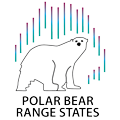Ensure that harvest of polar bear subpopulations is managed in a biologically sustainable manner in accordance with sound conservation practices
- Objective Leads
- Actions associated with Objective 4 in the 2020-2023 Implmentation Plan
- Polar Bear threats linked to the Objective and how the Objective’s Actions will address them:
- Expected impact (outcome) of the Objective:
- How the progress toward the Objective will be evaluated:
- Performance Metrics:
- Baseline of Performance Metrics:
- Liaison with other CAP-Objectives:
- Liaison with external bodies
- Expected dissemination of Deliverables and Outcome to stakeholders
Objective Leads
Caroline Ladanowski (Environment and Climate Change Canada,
Dave Gustine (U.S. Fish and Wildlife Service,
Actions associated with Objective 4 in the 2020-2023 Implmentation Plan
(see top-left sidebar for further information on the actions)
HM-A1: Define the components necessary for a “quantitative assessment of the population”
HM-A2: Define “biologically sustainable harvest” in terms of conserving polar bear subpopulations for future generations
HM-A3: Define the components of a “demonstrated sustainable harvest management regime”
Polar Bear threats linked to the Objective and how the Objective’s Actions will address them:
Unsustainable harvest
Levels of the Threats: Medium-low
Expected impact (outcome) of the Objective:
By ensuring that harvest is managed in a sustainable manner, we will contribute directly to the vision of the CAP (to secure the long-term persistence of polar bears in the wild that represents the genetic, behavioral, life-history, and ecological diversity of the species) by minimizing the threat of overharvest.
How the progress toward the Objective will be evaluated:
This suite of actions lays the groundwork for consistent assessments of harvest management regimes across the circumpolar arctic. To determine if harvest is sustainable in a given subpopulation, we first need to establish consistent definitions of the basic components needed to carry out an analysis. These actions provide the first step needed in this process, and will create a foundation for the implementation of harvest management actions in subsequent years. By ensuring that harvest is managed in a sustainable manner, we will contribute directly to the vision of the CAP by minimizing the threat of unsustainable harvest.
Performance Metrics:
Performance metrics for Objective 4 were defined in the midterm review of the CAP. They are as follows:
- The proportion of subpopulations with harvest which have a quantitative assessment of the population, including accounting for associated uncertainty
- The proportion of subpopulations where harvest data and associated uncertainty is available.
- The proportion of subpopulations where harvest is determined to be biologically sustainable based on a quantitative assessment.
- The proportion of subpopulations where quotas and harvest are within biologically sustainable limits (as defined by performance metric 3).
The definitions developed through the actions in this work cycle will be critical for measuring progress toward achieving Objective 4. Therefore, we cannot gauge our performance relative to these metrics at this time. Therefore, we propose that progress will be tracked relative to the following timeline:
Phase 1 (January–May 2021): Operating team will develop a draft white paper to define a quantitative assessment of the population (HM-A1), biologically sustainable harvest (HM-A2), and a demonstrated sustainable harvest management regime (HM-A3).
Phase 2 (June–September 2021). Operating team will seek review and feedback from PBSG writ large and other Range States countries on the draft white paper. In September 2021, an in-person meeting of the operating team (if COVID-19 situation allows), or a virtual meeting, will be held to consider the feedback.
Phase 3 (October 2021–February 2022): Range States representatives will facilitate domestic engagement on the report as determined necessary in each country.
Phase 4 (March–April 2022): Operating team will reconvene to finalize the white paper in consideration of feedback received in domestic engagement, and white paper will be submitted to Range States Heads of Delegation in April 2022.
Baseline of Performance Metrics:
Not yet developed, but will be developed in the next action cycle
Liaison with other CAP-Objectives:
Objective 6: Ensure that international trade of polar bears is carried out according to conservation principles.
Liaison with external bodies
(i.e. organizations, communities, stakeholders, expert groups, etc.):
The work will be conducted internally with input from each of the Range States. The PBSG will provide additional insights and consultation. Funding for PBSG expertise by Canada.
Expected dissemination of Deliverables and Outcome to stakeholders
(public, policy makers, legislators etc.):
Once approved by the HoD, the white paper will be posted on the Range States website. Individual Range States will share the white paper with relevant domestic stakeholders.
Potential Challenges and how they will be addressed (mitigation actions)[1]:
- Identifying and agreeing upon components that should be present in every sustainable harvest management regime while allowing for flexibility in how the program is delivered.
Level of challenge= minor (Level of likelihood (4) x the negative impact it may have (2) = 8)
Proposed mitigation strategy: We recognize that the implementation of harvest management may vary across the Range States, therefore some flexibility may be required. However, we will identify the key components that should be present in every sustainable harvest management regime and definitions will be based on the best available science.
- Lack of engagement from all range states
Level of challenge= minor (Level of likelihood (5) x the negative impact it may have (2) = 10)
Proposed mitigation strategy: conduct regular meetings to ensure the input of all the Range States is incorporated into the process.
[1] The level of challenge may be estimated by multiplying the level of likelihood (scale 1-5) by the negative impact it may have (scale 1-5). Minor: 1-10, Moderate: 11-15; Severe: 16-25.
